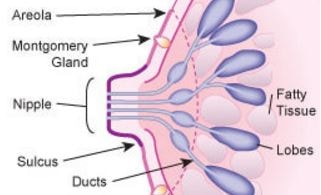Montgomery Glands
What is Montgomery glands?
Transition between mammary glands and sweat glands form Montgomery glands, which are also considered as sebaceous glands. The name of this gland is originated from an Iris obstetrician, William F. Montgomery, who first illustrated them in detailed. Montgomery glands are specific glands, which are only present in human female breast anatomy. Any stimulation excites the Montgomery glands, like cold temperature, touch, pregnancy. During pregnancy, the elevation is much more than usual. (1,3)

Montgomery tubercles
Montgomery tubercles are specific types of Montgomery glands are the slight elevated areas of the areola is prominent during early pregnancy. The sebaceous secretions are secreted from the Montgomery tubercles help to make the nipples and surrounding areas (areola) greasy and influence smooth breast feeding. The secretions of Montgomery tubercles also act as an anti-infective and provides benefit to the health of the child. The number of these glands varies in between 4 to 25 on each side of the breast. (1,2)
Location and Appearance
Areola is the area which surrounds the nipple and darker in skin color compare with other area of the breast, as this area provides the borderline of nipple and Montgomery glands. The surface of the areola mainly holds the Montgomery glands.
Usually in normal condition, the elevation of these glands is too little that they are not distinct. But certain factors stimulate them and regulate their visibility. During pregnancy, women often familiar with distinct projected reddish pink colored elevations in the surround area of the nipple. Other than this, tight fitted bra or cloths or any other type of pressure and arousal can stimulate Montgomery glands and they raise down in their own way. (3,4,5)
Function
Female breast nipples are made up of sensitive tissues and easily get irritated and dried with alteration of the internal or external stimulus in comparison with the normal skin. The oily secretion secretes from Montgomery glands helps to maintain the moisture content of the areola and other associated breast parts also prevents irritation. This oily secretion can also provide a surface coating on the nipple and prevent the entry of foreign objects through the nipple tip. (3,4)
Role of Montgomery glands in breastfeeding
Comfortable and smooth breast feeding is promoted by secretion of Montgomery glands. infants suck the nipple during breastfeeding and milk production is enhanced, both these factors can cause dryness and cracking of the nipple. This produces subsequent complications for both mother and infants. The proper functioning of Montgomery glands helps to balance the moisture content of the skin and grease the whole areola area.
Some scientific research data expected that the oily secretion could enhance babies’ hunger, principally after birth. It is expected that the oil secretion has some smell, which may stimulate the brain region of the newborn that controls hunger. To support this statement more research need to conduct in the future. (2,4)
Infection or irritation of Montgomery glands
- The location of the Montgomery glands sometime makes more susceptible towards development of the infection and irritation. Lactating mothers are more prone towards infection in mammary gland and it may spread to surrounding tissues.
- Fissure of nipple is the condition, in which frequent and repeated stimulus overwhelms the secretion ability of the gland. This need more lubrication of the nipple and that may not match with secretion levels.
- “jogger’s nipple” is the other condition which causes irritation of the nipple, it may happen when tight fitted bra need to wear foe prolong period. Other than irritation, some common symptoms include dryness, tenderness, or bleeding relating in one or both nipples. Consultation with doctors and proper medication heal the condition rapidly.
- Other associated medical conditions include clogging of the ducts and prevent the secretion, which enhance dryness, irritation, swelling and tenderness in the breast. The cause of the conditions may not involve only Montgomery glands, but also the areola and mammary glands are responsible for this. Gynecologists can evaluate the exact cause of the conditions. (2,4)
Problem Solving Tips
The following tips may help to prevent the Montgomery glands.
- Proper protective steps should maintain for nipple and surrounding area.
- Women who are involved in sports activities, properly choose the bra in terms of pressure generates in the breast.
- Surgical tape or bandage need to place between the nipple and clothing, which prevents excessive pressure during exercise regimen.
- Additional lubrication may need for a nursing mother to prevent dryness and cracking of nipple skin. But all available lubricating gel should not be applied during breastfeeding. Before choosing the lubricating gel, it should be ensured that lubricating gel safe for breastfeeding, as this gel may baby ingest during sucking. (4)
References
- Dr Craig Hacking and Dr Avni K P Skandhan et al.; Montgomery glands; Radiopedia.org; Retrieve from: http://radiopaedia.org/articles/montgomery-glands
- Montgomery Tubercles: an Early Sign of Pregnancy? (2015); Retrieve from: http://www.checkpregnancy.com/montgomery-tubercles/
- Gayane Dolyan Descornet; Montgomery Glands; Women Health & Lifestyle; Retrieve from: http://www.women-info.com/en/montgomery-glands/
- What Are the Parts of a Nipple and Areola?(2016); Medical Review Policy; Retrieve from: http://breastcancer.about.com/od/whatisbreastcancer/f/nipple-anatomy.htm
- What are Montgomery Glands?; wiseGEEK; Retrieve from: http://www.wisegeek.org/what-are-montgomery-glands.htm
